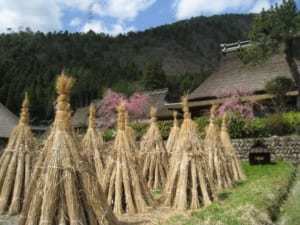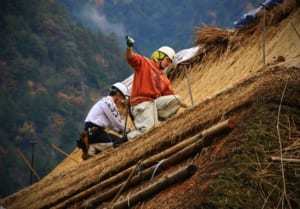The region of Miyama has nearly a thousand thatched houses, and is home to a thriving community of thatchers who are preserving this ancient art. If your timing is good, you can take part in thatching activities and there are a number of cafes, restaurants, museums and places to stay with thatched roofs.
The main material used in thatched roofs is miscanthus grass, which can be seen growing all over the region. For many generations, the people of Miyama have planted and maintained Kayaba or meadows of miscanthus grass. In the past, these meadows were communally maintained and harvested in order to ensure a constant supply of thatching material. This tradition is continued today, on a smaller scale; cut thatch can be seen drying in the fields during late November and December.
By storing the dried miscanthus grass in the loft of a thatched house, the raw material is ready and waiting for the thatcher exactly where it is needed, to replace the roof at the end of its 30-40-year lifespan. After being replaced, the old thatch is used as organic fertilizer and mulch, returning back to the soil it was grown in, to complete the cycle.
Thatch is not only an eco-friendly building material, but also creates a roof that breathes; air comes in through the gaps between the dried miscanthus, making a thatched house a cool and pleasant place to be in mid-summer, without using an air-conditioner as most modern houses need to. Thatched roofs offer protection against typhoons; by allowing some of the wind to pass through the roof, the full force of the wind doesn’t push against it, which can cause more solid roofs to be ripped off completely.
The Japanese have been thatching their roofs for over five thousand years. As long as there is water, sun, earth and air, miscanthus grass is an endless supply of roofing material. Using grass as the material for the roof helps to create a deep connection with the soil, the seasons and the yearly cycle of new growth, maturity and harvest.
Each region throughout Japan has its own unique style of thatch that suits the local climate; in particular, the slope of the roof is steeper in northern areas, in order to shed snow more easily.
It takes around one month to thatch a typical house, but up until 80 years ago thatching was an annual event, which the whole village took part in. With plenty of hands to help out, it only took a few days to complete one house. Thatchers travelled from village to village, and were given free board and food in the house they were re-thatching.
After the job was completed, the thatcher would hold out his hat and everyone from the village would put in a little money. In Miyama, certain communal buildings and areas are still maintained by contributions from each household in the village.
The irori, or Japanese hearth, can be found in all old thatched houses, and the smoke from the Irori can be seen gently puffing out of the special air vents in the thatched roof. As well as keeping the house warm and dry, the smoke rising up through the thatch deposits a layer of soot which hardens and protects it from insects and rot.
In Miyama, the thatched houses have X-shaped wooden structures on the roof called Umanori. These Umanoriare always present in odd numbers, which are considered more auspicious than even numbers in Japan. In times gone by the number of Umanori told you about the profession and therefore the social status of the family who live there. Now this system has been abandoned, but you can still see that most houses have five Umanori signifying a farmer’s house, some have seven indicating a merchant, someone who bought and sold goods. A house with nine Umanori would belong to the head of a village, and very occasionally you might see eleven which would represent the head of a larger area like the whole of Miyama. Resting on the Umanori is a thin tree trunk that is called a Karasu-domari which means the resting place of crows.

One more very important feature is the family crest or Kamon which can often be seen in the triangle found at the end of each side of the thatched roof.
If you look around you’ll see that some villages tend to have the same Kamon, indicating that lots of relatives lived near to each other. Natural patterns and symbols usually form the basis of Kamon such as plum blossom, Ginko leaves, storks and flowing water motifs.
Understanding a little more about the thatch and the culture behind it will help you appreciate it more deeply. When you visit Miyama, keep an eye out for the number of Umanori, for crows resting on the Karasu-domari and for the Kamon on the side of the house.











